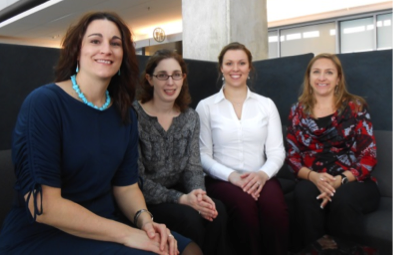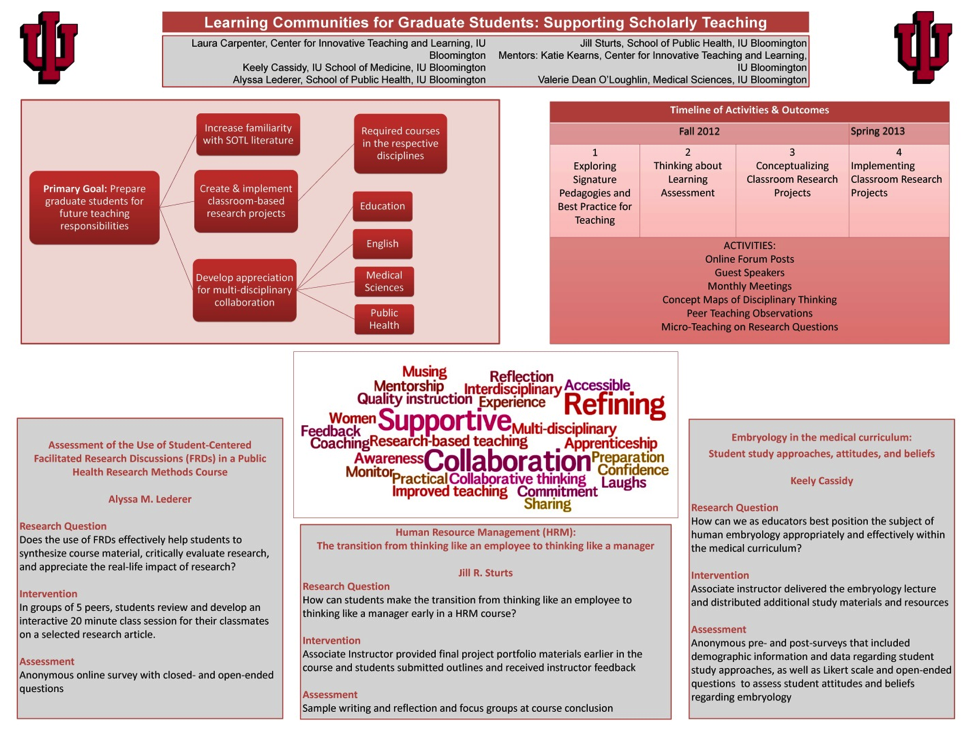With the support of graduate student colleagues, faculty mentors, and consultants from the Center for Innovative Teaching and Learning, graduate student participants in the Paths to the Professoriate Graduate Student Learning Community (GSLC; 2012-2013) developed innovative approaches to address challenges in student learning and presented their work in several scholarly contexts.
Co-facilitators Valerie O’Loughlin (Medical Sciences Program) and Katie Kearns (CITL) based the design and activities of the GSLC on the Teagle Foundation-funded "Collegium on Inquiry in Action." The graduate students’ teaching innovations were grounded in pedagogical literature (e.g., Classroom Assessment Techniques (Angelo and Cross, 1994); How People Learn (Bransford et al., 2000); Classroom Research: Implementing the Scholarship of Teaching (Cross and Steadman, 1996); Signature Pedagogies (Gurung et al., 2008)) as well as discipline-based educational research they examined during the fall 2012 semester. Each graduate student’s plan included quantitative and qualitative methods to assess student learning:
- Jean Jung, a graduate student in the School of Education, redesigned a Case Analysis project in an Education (IST) course, so that it had more procedural scaffolding and involved actual teachers to increase the authenticity of the project.
- Keely Cassidy, a graduate student in the Medical Sciences Program, studied the extent to which medical students, when supplied with supplemental materials on head and neck development and related birth defects, exhibited a change in their learning process and perceptions/feelings toward embryology.
- Jill Sturts, a graduate student in the Department of Recreation, Park and Tourism Studies in the School of Public Health-Bloomington, explored ways to facilitate an active learning environment while helping students make connections to course content that continuously reinforce the notion of thinking (and applying) from a management perspective.
- Laura Clapper, a graduate student in the Department of English, explored how metacognitive tools such as minute papers help students in an introduction to analytical writing course see more relevance in their W170 coursework and perform analytical reading and writing strategies more in their own research.
- Stacy Dunham, a graduate student in the Medical Sciences Program, used practice tests and metacognitive reflections to help students identify successful study strategies for course exams.
- Alyssa Lederer, a graduate student in Applied Health Science in the School of Public Health-Bloomington, helped students connect critically and positively research and evaluation methods in health and safety, using facilitated research discussions.

Laura Carpenter, Alyssa Lederer, Keely Cassidy, and Jill Sturts
E.C. Moore Symposium at IU Indianapolis, April 2013
While the number of participants in the GSLC was small, the impacts for the six graduate students, their departments, and the SOTL community were substantial. Participants came to view the Institutional Review Board process as an instructive, rather than onerous, component of conducting scholarship on teaching and learning. Furthermore, teaching interventions developed by the graduate students were adopted in multi-section courses and adapted in other courses. Finally, GSLC participants presented outcomes of their teaching innovations at the Edward C. Moore Symposium on Teaching and Learning at IU Indianapolis in April 2013. In addition, one participant presented her GSLC project findings at the Human Anatomy and Physiology Society annual conference in May 2013. The Paths to the Professoriate Graduate Student Learning Community provides additional evidence that multi-disciplinary communities support mid-career graduate students’ as they become reflective and intentional teacher-scholars and prepares them to be successful future faculty.

Poster prepared by GSLC members for presentation at the E.C. Moore Symposium at IU Indianapolis in April 2013.
References
Angelo, T.A. and K.P. Cross. (1994). Classroom Assessment Techniques: A Handbook for College Teachers. San Francisco, CA: Jossey-Bass.
Bransford, J. D., Brown, A.L., & Cocking, R.R. (Eds.). (1999). How People Learn: Brain, Mind, Experience, and School. Washington, DC: National Academy Press.
Cross, K.P and M.H. Steadman. (1996). Classroom Research: Implementing the Scholarship of Teaching. San Franciso, CA: Jossey-Bass.
Gurung, R.A.R., Chick, N.L., Haynie, A., & Ciccone, A.A. (2008). Exploring signature pedagogies: Approaches to teaching disciplinary habits of mind. Sterling, VA: Stylus.

